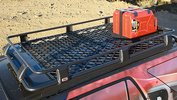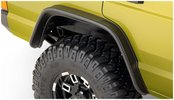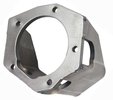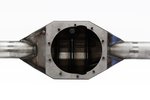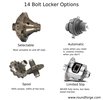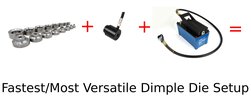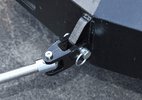How Much Do Synthetic Winch Rope and Wire Rope Weigh?
- The Best Winch Accessories For Synthetic Winch Ropes
- How Much Winch Line Will Fit on Your Winch?
- The length of winch line is different between the steel and synthetic versions: This is very common.
- The fairlead is steel, not aluminum: For instance, the Warn VR series uses a steel hawse on both the steel cable and synthetic versions of the winch. More expensive winches will use an aluminum hawse with synthetic.
- The drum size is different between the steel and synthetic versions: This seems to be less common.
- The full weight of your rig, including you, passengers, gas/coolant/oil, tools, tires, spares, camping gear, armor etc.
- How badly you're stuck
- If you're tires can roll
- If you're on a slope
Synthetic Winch Rope and Wire Rope Weight Calculator
Put Your Winch on a Diet
Winches are heavy. They're heavy to ship, heavy to move around, heavy to install, and heavy hanging off the front of your rig.
Switching to synthetic winch rope can give you a very substantial weight
savings. A Warn M12 winch weighs in at 136 lbs from the factory with
125 feet of 3/8" steel cable and a steel roller fairlead.
If the Warn M12 sat on a quarter, it would squeeze a booger out of George Washington's nose.
But switching to synthetic winch rope and using an aluminum fairlead brings the weight down to 100 lbs, a 36 lb savings. This is more than 25% of the winch's original weight!
Similarly, an 8274 can also see huge weight savings with synthetic winch rope and an aluminum fairlead, dropping from 110 lbs to 78 lbs. This is a 29% reduction in weight.
If you have a hitch-mounted winch or a portable winch setup, dropping a 1/4 of the weight makes it a lot easier to maneuver.
| Factory weight | Light weight | |
|---|---|---|
| Total winch weight | 136 lbs | 99.9 lbs |
| Winch line | 30.4 lbs (steel cable) | 4.3 lbs (synthetic winch rope) |
| Fairlead | 11.5 lbs (steel roller) | 1.5 lbs (aluminum hawse) |
| Winch line + fairlead | 41.9 lbs | 5.8 lbs |
| Factory weight | Light weight | |
|---|---|---|
| Total winch weight | 110 lbs | 78.1 lbs |
| Winch line | 26 lbs (steel cable) | 4.1 lbs (synthetic winch rope) |
| Fairlead | 11.5 lbs (steel roller) | 1.5 lbs (aluminum hawse) |
| Winch line + fairlead | 37.5 lbs | 5.6 lbs |
Why Are Roundforge's Calculated Weights different than the Manufacture's Specs?
Manufacturers often offer two different versions of a winch, a winch with synthetic winch line and one with steel cable. We've encountered a few situations where the weight we calculate for a "synthetic line" winch or a "steel cable" winch is a different from what the manufacturer actually says.
There are a few reasons this can happen:
Sometimes, winch manufacturers make mistakes! We've seen lots of errors and inconsistencies where numbers are switched or were clearly just entered incorrectly.
A Little About Working Load Limits and Winch Cables
It pays to be super careful about how you use your winch and how you take care of your winch cable. Why? The winch cable supplied with your winch is undersized. Manufacturers often recommend a winch that's rated for 1 1/2 times the weight of your 4x4. But frankly, we think a lot of people wing it or get what their buddies have.
The actual force that your winch needs to generate is determined by:
And, very importantly, the majority of winching operations probably exceed the actual Working Load Limit (WLL) of the winch cable. Yes, really. WLL can also be described as the maximum allowed weight or the weight you are not allowed to exceed. The WLL of steel 5/16" cable is 1960 lbs. No joke. The breaking strength is 9800 lbs.
Why do manufacturers get away with this? Probably because we offroaders don't want to be lugging around huge cables or having another 30 lbs hanging off our front bumpers. We can also deal with this by using snatch blocks and double line pulls. But you should always know that your recovery operations can easily take you to the breaking strength of your winch cable.
When you take into account the load factors above, it's easy to see how you can snap a cable. This is the reason recovery dampers exist.
Synthetic Winch Rope vs. Steel Cable
Steel winch line is also known as aircraft cable or galvanized wire rope. For 3/8" and under, it is 7x19. This means that there are 7 main strands that are each made up of 19 individual strands. Wire rope above 3/8" is 6x19 although it's construction and appearance are fairly similar to 7x19 for our purposes. The common wire rope on winches is galvanized. Stainless steel is available, but it's significantly weaker than galvanized steel.
Most winches have standardized wire rope that you can buy just about anywhere. Galvanized wire rope from one manufacturer will match the galvanized wire rope from another.
Synthetic winch lines have the same WLL issues as steel cable although they still tend have higher breaking strengths than a comparable diameter steel cable. Synthetic lines are safer than steel, as well. Besides not producing burrs and splinters that'll cut your hands, they also don't whip as much as steel when they break.
Unlike steel, synthetic can be spliced on the trail and still fit on the drum. Steel cable requires clips that would just mash your cable if you could even get it on the drum.
Synthetic is also easier to play out. If you have a spotter manning your winch line, he or she will be happy to be dealing with 4 1/2 lbs of winch line rather than 30 lb.
It's also possible to drop a diameter size and get a comparable-strength rope using a higher-strength synthetic. This can enable you to get even more winch line on your winch drum although this can be expensive. The biggest downside to synthetic winch line is that it's more susceptible to abrasion and UV light.
Some winch rope can be a little pricey so we see a lot of people using shorter winch lines. This can actually be a good thing - the fewer wraps of line you have on the drum, the less your winch has to work. Basically, when you're on the trail a short winch rope means that your winch is always generating more power compared to it having a long winch cable.
But what do you do when you need to reach a far away anchor? Simple, you either get out a non-stretch winch extension strap or you use a winch ground anchor.
Last updated: September 5, 2019
